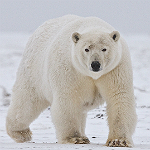Historic CMS CoP11 passes profound wildlife conservation decisions9th November 2014  CMS CoP11 has concluded, marking it's place in conservation history as a historic and profound conservation meeting. CMS CoP11 has concluded, marking it's place in conservation history as a historic and profound conservation meeting.
Wild Migration will report further news in the coming days. The following provided a very brief synopsis.
Thirty-one proposals to add species to the Convention’s Appendix I and II were approved. These included the addition of a record number of 21 shark, ray and sawfish species; Cuvier’s beaked-whale; polar bear; semipalmated sandpiper; the great knot; the European roller; great bustard; Canada warbler; red-fronted gazelle; white-eared kob and the European eel.
Tine Sundtoft, the Norwegian Environment Minister, proponent of the polar bear listing said “Norway is deeply committed to the conservation of polar bears and to the continued cooperation with Range States, other countries and stakeholders to achieve this end”.
The polar bear, the largest apex predator on Earth is affected by climate change that has led to the loss of 2 million m2 of sea ice. The Appendix II listing introduces the global perspective of existing threats to Arctic species stemming from shipping and oil exploration, making it a case for all CMS Parties.
Three Species Action Plans were approved: for the Argali Sheep in Central Asia, the Pacific Loggerhead Turtle and the Saker Falcon. In addition a regional initiative covering large migratory mammals in Central Asia, such as the Bactrian Camel, the Snow Leopard and the Saiga Antelope, was launched together with an accompanying publication called “Central Asian Mammals Initiative: Saving the Last Migrations”.
The adoption, by CMS Parties, of the global Guidelines to Prevent the Risk of Poisoning of Migratory Birds is a significant step forward. A key element enshrined in the Guidelines is to phase out the use of lead gunshot in all environments over the next three years, fully supported by the hunting associations.
For the first time, the threat posed by renewable energy technologies to bats, birds and cetaceans was on the agenda. Guidelines on how wind turbines, solar panels, dams and other forms of renewable energy developments can be deployed in a wildlife-friendly manner were also adopted by COP.
In the marine environment, Resolutions were passed concerning plastic and other debris, live capture of cetaceans and boat-based wildlife watching. Among these decisions Parties agreed to progress work to encompass cetacean culture into future decision making, while also extending this important work to other species such as elephants and primates.
A very important resolution for Wild Migration was also adopted to enhance the relationship with civil society and in particular NGOs.
Parties adopted the Strategic Plan for Migratory Species, which mirrors the Aichi Targets of the Convention on Biological Diversity to meet the Parties’ requirement that biodiversity-related agreements work ever more closely together.
The objective of the Plan is to help integrating the needs of migratory species in national and international action plans. Details on how CMS and the civil society should implement the Strategic Plan including indicators to measure progress will be made available at COP12 in 2017.
In their closing comments many delegates said the COP11 marked a milestone in the development of the Convention, which was better placed than ever to fulfill its mandate to conserve endangered migratory species.
|











